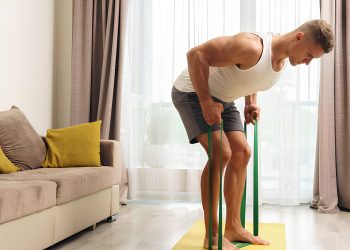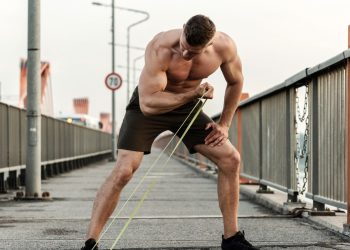The biggest knock on resistance bands is after a certain point, they’re useless for building strength. They only come so thick and they only stretch so far before the band breaks. As opposed to the barbell where you can keep on adding plates.
But using them for accessory exercises will help improve your lifting numbers on your squat, bench and deadlift by working on weaker parts of the lift by giving extra assistance or resistance during the lift itself.
One of the advantages of bands is they don’t rely on gravity for resistance so you can do a variety of exercises at different angles and can add them to most dumbbell, kettlebell or barbell exercises.
Using bands is a great way to add variety to your routine and it gives your joints a break from the constant pounding of gravity and the barbell.
Consider adding these band exercises to your routine for a stronger you
Deadlift accessory
A. Half kneeling split stance Pallof Press
Two factors for better deadlifting are full-body tension and hip mobility.
Level Up Your Fitness: Join our 💪 strong community in Fitness Volt Newsletter. Get daily inspiration, expert-backed workouts, nutrition tips, the latest in strength sports, and the support you need to reach your goals. Subscribe for free!
And performing this exercise before deadlifting will help “prime” your muscles (much like plyometric jumps before squatting) around the core to providing the tension needed to protect your spine while training your hip mobility too. (1)
Furthermore, the adductors, along with the hamstring act as the brakes on the eccentric part of most leg exercises. So, keeping them strong and mobile is in your best interest.
The trick here is not to fatigue your core before lifting heavy but to fire it up. Doing 20-30 seconds (or 8-12 reps) on each side before you pull is plenty.
For example:
1A. Half Kneeling Split Stance Pallof Press 15 seconds each side
1B. Deadlift variation 3-5 reps
B. Horizontal band resisted deadlift
Note- Loop the band around the middle of the bar before your put plates on.
If you’re an experienced deadlifter you’ve heard the terms ‘squeeze your armpits,’ ‘chest up” or ‘pull the slack out of the bar.’ All these terms activate the lats.
Lats are a major player in the deadlift. Keeping them “tight” before and during the pull keeps the bar traveling on a straight path and the spine neutral, which is essential for a stronger and safer deadlift.
This exercise encourages a tight starting position essentially forcing the lifter to pull slack out of the bar because if you don’t, the bar will get away from you. And that would be embarrassing.
Do this move on the upper body, squat days or replace your regular deadlifts if you’re having trouble keeping your lats tight.
Pairing this in a superset with a hamstring variation will really hammer your backside.
For example,
1A. Band resisted deadlift 6- 8 reps (use 70-80% 1 RM to start with)
1B. Hamstring curl variation 8-12 reps
Or if you want to attack your upper back and lats try this superset on for size.
1A. Band resisted deadlift 6-8 reps
1B. Straight arm cable pulldown 8-12 reps
Squat accessory
A. Band around knees squat
Knees caving in excessively or knee valgus during the squat is a common squat error and one the lifter can’t tell is happening. Enter the looped band around the knees to ‘feed the dysfunction’
This is what’s called reactive neuromuscular training or RNT.
RNT uses outside resistance to turning on an automatic response which in this case is to push the knees out.
RNT exercises improve stability and help clean up faulty movement patterns by employing instinct, as the body resists and reacts to the resistance of the band.
If your knees are caving in during the banded squat, you’ll know about it.
And another benefit is it will encourage you to maintain full-body tension in the hole. To further enhance this effect, use a 3-second pause because combining a pause with the band will help fix any squat technique issues.
This can be used as an accessory movement on leg day or your main squat movement if you’re having issues with your knees caving in under heavyweight.
For example,
1A. Paused squat with a band above knees (3-second pause) 6-8 reps
1B. Lateral band walks 15 reps on each side.
B. Band around waist
If you’ve noticed a weight shift to one side during your or training partner’s squat, using RNT will help fix this faulty pattern too by again feeding the dysfunction.
Some reasons for a weight shift in the squat are-
- Those with Femoral Acetabular Impingement (FAI) on any given side will block/impinge quicker on that side and causes the shift as a form of compensation.
- Lack of kinesthetic awareness or unaware of your body’s position while squatting.
Either way, using RNT will help clean this up. This method is best used for any type of dumbbell/kettlebell squat as you can tie the looped band around the squat rack. Or if you have a training partner, they can anchor a band for you.
For example,
1A. Goblet squat with a band around waist 8-12 reps
1B. One arm resistance band row 12-15 reps on both sides
Bench Press Accessory
A. Dumbbell bench press with bands
Instructions
- Depending on your strength, wrap a light to moderate resistance band around your back like you’re putting on a backpack
- Hold the ends of the band in your hands, making sure they are free enough to hold the dumbbells
- Grab the dumbbells and lie down on the bench
The resisted dumbbell bench band press allows you to challenge the range of motion where you and the band are strongest to help build lockout strength. (2)
Do this as an accessory exercise on upper body days. Use dumbbells you can press for 12-15 reps or around 50% 1RM.
For example,
1A. Dumbbell bench press with bands 8-12 reps
1B. Band pull apart 12-15 reps
B. Band-assisted Bench Press
If you’re having trouble at the bottom of the bench press this exercise is for you.
When the band stretches as you lower the bar, it helps brings your arms back together and helps lift the bar off the chest because of the rebound effect of the band.
Furthermore, while in the bottom position the band assists the shoulders in horizontal abduction which makes the weight easier and (may) allow you to use more weight.
There are two ways you can do this
- Use a load of 90% 1 RM and with use of a spotter go till technical failure
- Use a load of between 70-85% 1 RM to develop hypertrophy
Pairing this with a band exercise in a superset works well.
For example,
1A. Band assisted bench press
1B. Band bent over row 12-15 reps
Wrapping up
Using bands for assistance, extra resistance or to clean up weakness will help you get stronger and keep you injury-free longer. And being injury-free leads to more gains and better lifting numbers for you.
Nothing wrong with a bit more flex time.
References
1. J Strength Cond Res. 2002 Feb;16(1):75-82. The effect of heavy- vs. light-load jump squats on the development of strength, power, and speed. McBride JM1, Triplett-McBride T, Davie A, Newton RU.
2. David García-López, et. al., “Free-weight augmentation with elastic bands improves bench-press kinematics in professional rugby players,”Journal of Strength and Conditioning Research.








